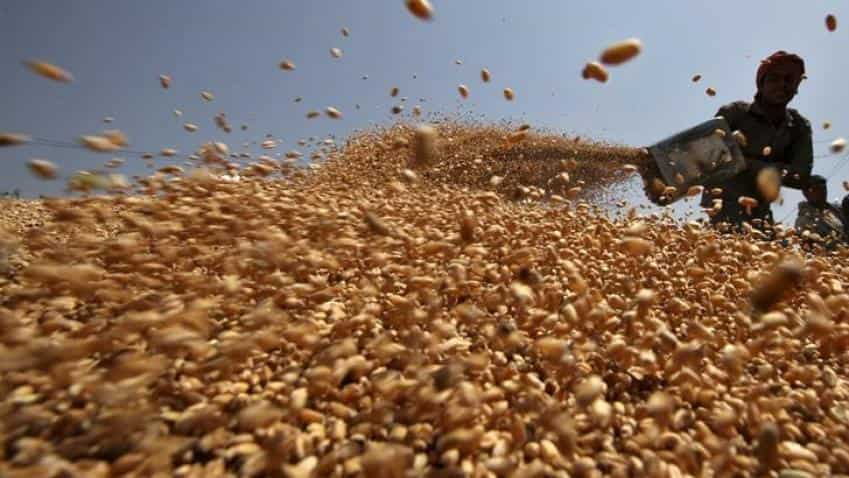India's wheat, pulses output seen rising, to curb imports

India`s production of wheat and pulses is expected to jump in 2018 as a hike in the government`s assured purchase prices and ample rainfall have prompted farmers to plant more of the winter crops, industry officials told Reuters.
Higher production will help the south Asian country reduce imports of pulses in the 2018/19 fiscal year starting April 1 and and could allow it to avoid buying overseas wheat for the first time in three years.
"Given the better realisation there should be at least a 5 percent rise in wheat sowing," said Harish Galipelli, head of commodities and currencies at Inditrade Derivatives & Commodities.
"Wheat prices are stable. Government has raised minimum support price and import duty. This will certainly encourage farmers to expand area."
The world`s second biggest wheat producer earlier this month doubled the import tax on wheat to 20 percent.
In October, India raised the price at which the federal government will buy new-season wheat from local farmers by 6.8 percent to 1,735 rupees ($26.93) per 100 kgs (220 lbs).
An expected increase in wheat production to a new high and rising stockpiles meant India would not need to import wheat in 2018/19, an official with state-run Food Corporation of India said.
Wheat stocks with government agencies stood at 23.9 million tonnes as on Nov. 1, up 27 percent from a year ago following record output in 2017, added the official, who declined to be named.
India has imported wheat for the past two years after local production fell due to successive droughts in 2015 and 2016.
The country imported 5.75 million tonnes of wheat in 2016/17, the most in a decade. India imports wheat mainly from Ukraine, Australia, Bulgaria and Russia.
Ample rainfall in October and higher-than-normal water level in reservoirs will ensure better yields in the current season, said Inditrade`s Galipelli.
India`s wheat output in 2017 rose 6.7 percent from a year earlier to a record high 98.38 million tonnes.
Farmers are likely to expand the area given over to chickpeas by nearly 20 percent, said Pravin Dongre, chairman of the India Pulses and Grains Association.
"Chickpeas gave better returns to farmers than oilseeds. Initial reports are indicating a significant jump in sowing," Dongre said.
Chickpea, also known as chana, is the main winter-sown pulse crop in India. A rise in chickpea production will help the country reduce pulses imports in 2018/19, he said.
India, the world`s biggest importer of pulses, shipped in 6.6 million tonnes of mostly peas in fiscal 2016/17.
The government`s decision to raise the chickpea support price by 10 percent and a recent move to impose a 50 percent import duty on peas will lure farmers to plant chickpea, said Nitin Kalantri, a pulses miller based at Latur in Maharashtra.
In 2016/17, India`s pea imports jumped 41 percent from a year earlier to a record 3.17 million tonnes.
India imports peas mainly from Canada, Russia, United States and France.
Get Latest Business News, Stock Market Updates and Videos; Check your tax outgo through Income Tax Calculator and save money through our Personal Finance coverage. Check Business Breaking News Live on Zee Business Twitter and Facebook. Subscribe on YouTube.
RECOMMENDED STORIES

Small SIP, Big Impact: Rs 1,111 monthly SIP for 40 years, Rs 11,111 for 20 years or Rs 22,222 for 10 years, which do you think works best?

SBI 444-day FD vs PNB 400-day FD: Here's what general and senior citizens will get in maturity on Rs 3.5 lakh and 7 lakh investments in special FDs?

SCSS vs FD: Which guaranteed return scheme will give you more quarterly income on Rs 20,00,000 investment?

Rs 3,500 Monthly SIP for 35 years vs Rs 35,000 Monthly SIP for 16 Years: Which can give you higher corpus in long term? See calculations
10:17 AM IST










 Centre, ADB sign $350 million loan to boost India's supply chains
Centre, ADB sign $350 million loan to boost India's supply chains Rupee rebounds from all-time low, gains 10 paise to close at 85.03 against US dollar
Rupee rebounds from all-time low, gains 10 paise to close at 85.03 against US dollar India's import of Russian oil drops in November on shrinking discounts
India's import of Russian oil drops in November on shrinking discounts India, Kuwait sign MoU to establish Joint Commission for Cooperation
India, Kuwait sign MoU to establish Joint Commission for Cooperation Swiggy Q2 results: Loss narrows to Rs 625 crore, revenue surges 30% YoY
Swiggy Q2 results: Loss narrows to Rs 625 crore, revenue surges 30% YoY